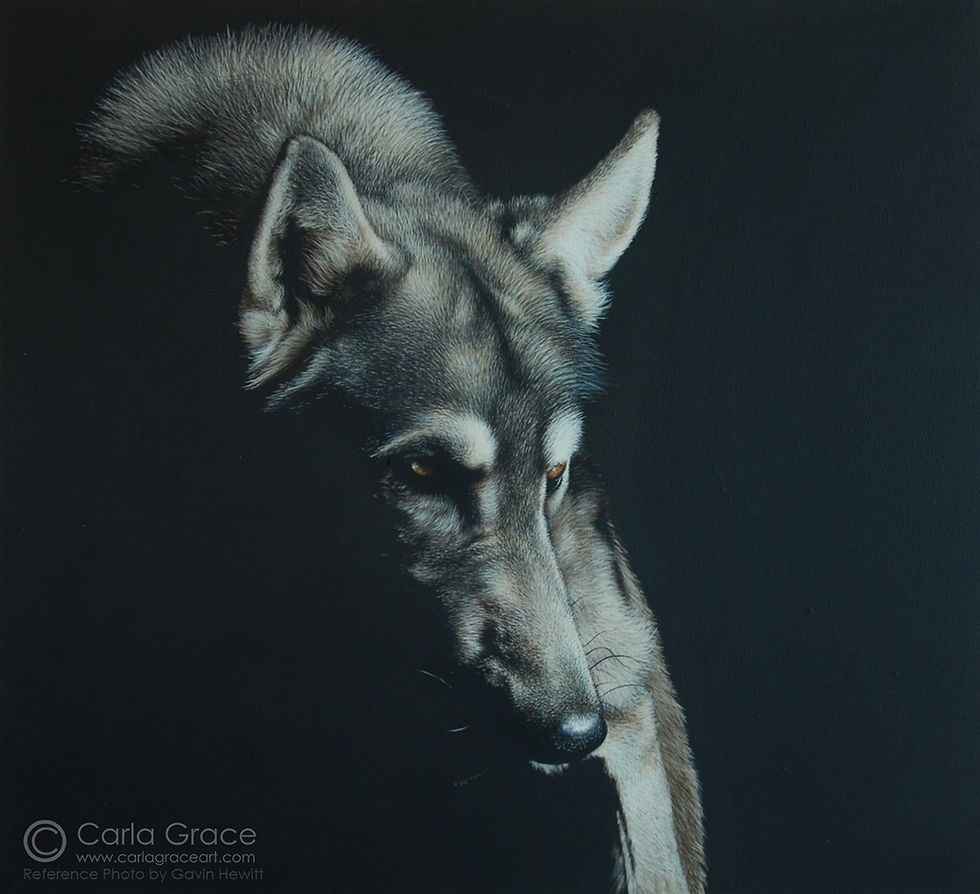How to Paint a Grizzly Bear without loosing your mind.
- Carla Grace
- Apr 20, 2016
- 4 min read

The mastery of trial and error that I call my art work has lead me to the creation of a grizzly bear that I am proud to present to the world. I had never painted fur before, and so in my confidence decided after watching a few tutorials on YouTube that it would be a piece of cake. Wrong. So wrong. I have decided, in order to save another artist some time and tears, I would break down the process I ended up developing to create this splendid image.
The tools I ended up using:

As you can see the colours are very basic and I feel like they are laughing at me through their devilish yet charming pigments. I changed the base layer of this bear so many times until I eventually came to the conclusion that I was trying to mix too many colours together.
Your base layer is going to determine how the top coats appear to the eye. I can't stress enough just how important it is to get the base pretty much right.
The Base:
Burnt Umber. The whole thing, Burnt Umber. This made the bear look like a pile of poop on the canvas. I then drew the outlines and questioned why the heck I was doing this.
First Layer:
This is going to be the layer that structures the direction of fur. So take your time on this - not like I did - and do it right so that you don't get confused when you start to add details later.
Equal Parts Raw Sienna and Yellow Ochre with a touch of white to make it opaque.
I used the second brush in the photo for basically all the fur. (If you use more Yellow Ochre, you make the fur brighter and more saturated in looks. I encourage rather than doing that, add more white if you want the highlights brighter. Adding more Raw Sienna will give you middle tones, which are always lovely for later on)
Once you have done the fur structure over the whole bear. Have a glass of wine. Life has slowed down drastically and you are wishing it was finished already. You're not.
Dilute some Burnt Umber. Make this life saver watery and grab the brush you want to use for this step (for me, I used the fourth item in the photo) and brush this diluted colour over the whole of your painting. This step is repeated after every layer, as it blends the fur together and gives it a warm, deep brown hue. It also makes the base layer neutral, rather than carrying a dominant green undertone or orange undertone. SO important. This took me ages to figure out. You are welcome.
Every layer after the first layer:
As you build up the layers of fur, it will be different balances of Raw Sienna and Yellow Ochre with a touch or more of white. More white for brighter parts and more Raw Sienna for deeper parts. Brushing over with dilute Burnt Umber to add depth and to blend.
The shadows:
Burnt Umber. Not diluted. So easy. See why I feel like I was being laughed at?!
Deep Shadows:
Burnt Umber with a touch of Black Mars - Not too much... Black is not a natural colour
Orange Glow:
The parts that are kissed by the sun shining through layers of fur give off a strange orange glow...
Just use Raw Sienna and yellow Ochre. No white.
In some parts, the glow will seem more red than orange: Red oxide and Yellow Ochre will do the trick.
Medium Tones:
Rich red brown - Burnt Umber & Red Oxide
Light Brown - Burnt Umber, Red Oxide, Yellow Ochre & White
Wet Highlights and Low Lights:
Burnt Umber & White (this will dry as a silvery/greyish colour over the other browns. Add small amounts of your Raw Sienna, Yellow Ochre & white mix, which you should have a tone of as you will be using it in everything to make it more or less matching to the fur in the lighter parts). This is the colouring you will blend for the ears or any part that is full of mud and water.
Water drops and Sand on the fur:
Raw Sienna and Yellow Ochre with lots more white.

The Skin on the Nose:
I actually can't remember what I did here... I think I used the smallest amount of burgundy with white and burnt umber... Basically Im going to say "good luck" for this part... I have no idea. Useful. I know!
So basically, after you have spent days dealing with so much bear, and you feel like you can't remember what it is to talk to another human being or what the sun feels like on your skin... You realise that you have not only achieved something pretty awesome, but that you really don't know anything about bears. It's at this point that you google everything there is about bears, feel intelligent and tell your partner all your new cool facts, and then forget everything right away. Hi 5 knowledge. So much has been accomplished today.
Make sure you paint it life-size... way bigger then it needs to be, have an emotional break down half way through and vow never to paint such a stupidly big painting again. And possibly practice painting fur first before tackling the actual thing. I have learnt a lot about myself the past couple weeks... And my next project is a life-size turtle... the same size as the bear... wait, I haven't learnt a thing. And that's how you paint a grizzly bear.




Comments